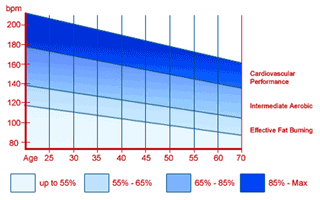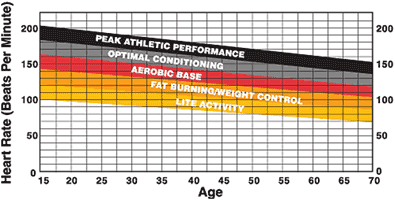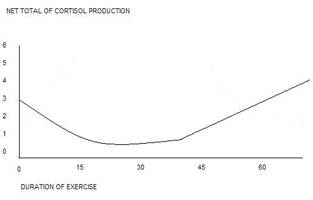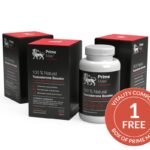One simple fact that you have to live with as a bodybuilder/fitness or figure athlete is cardio. You can starve yourself to death, but that aerobic response is the only thing that will get you firm and really lean. You have to do the cardio to get lean, and if you do a lot, then you will get really lean. So it isn’t a question of ‘To Do’ or ‘Not To Do’, but a statement of ‘Just Do It’.
The next question is how much and how often? Still, another question is which cardio is best? Can I do too much cardio and which form of cardio is best? To answer these questions, I have to step back and offer some settings for my answers.
I have been very privileged to have had some of the top exercise professors in the world. Dr. Fox (Interval training), Dr. Bartels (tested more swimmers than you have ever seen), Dr. David Lamb (wrote your textbook), Dr. Kirby (set up just about every cardiac response protocol), Dr. Harper (Harvard step test) and Dr. Mathews; all read like a who’s who in the exercise physiology field.
Specifically Don Mathews; who was the king of testing and measurement and statistics in exercise. While I was in Dr. Mathew’s classroom, our time was often spent working through theory and data that steered the fitness world. One such discussion was on the topic of aerobic response.
Dr. Mathews was discussing the point of cardiac response in relation to the duration of exercise time. At that time, the “20-minute workout” was being widely marketed and accepted. The general idea was that you could get everything you needed from exercise in just twenty minutes, but the whole theory came crashing down with some simple data.
Consider This
The body uses various energy systems that are turned on and off, based on the length of time that someone is exercising. Somewhat based on how intense they are exercising, but not what they ate, nor what they took; it was a chemical reaction that had specific requirements for each energy system to work.
Cardian Response occurs in the body in a specific order. The chemical reactions are like dominos, one causing the next and were based on heat, oxygen, and various chemical availability.
Again, they always occur in a specific order as the development of each exercise period begins and is maintained.
They are in order of appearance:
- ATP-PC cycle
- Lactic Acid cycle
- And finally the Beta Oxidative cycle
Each requires certain stimuli to begin and will eventually lead to the final Beta Oxidative cycle (Fat Burning), which continues on until the exercise stops. You can increase the intensity and call upon the first two systems, but you will not stop the fat-burning process once it starts. See Table 1 /Energy Systems
TABLE 1: Energy Systems

- An example of energy systems is shown below. Note that various systems are used depending on the duration (length of time) of exercise. Notice that the blue shows the initial onset of exercise then the peach/tan colour, then the green shows the longer exercise. Note that the onset starts depending on the intensity of the exercise.
Thoughts To Ponder
This raised an interesting question for me to bring up in class. Once you turn on the process, the chemical reactions were set into motion and they caused other chemical reactions to occur. I then asked a simple question, “If we have a reaction after just 5 minutes, why keep exercising for twenty minutes?”
Dr Mathews response was simple,
“I don’t know who or why they recommend that time period. Once you activate the chemicals, the changes occur within the body and will eventually alter the setting of the fat thermostat. The only reason to continue on after five minutes is based on the need to maintain the fat burning process.“So marathon runners need to condition themselves to maintain that long term aerobic state, but the chemical reactions level off after just a few minutes and actually begin to lower after ten minutes.”
Now you could hear a pin drop in that room. As I said, at that time, the twenty-minute workout was very popular with several health clubs. It cast another truth on the fact vs. fiction on the world of exercise and should be looked at here to help you control your current exercise program.
How Does This Effect You?
The point is when you exercise you stimulate the cortisol inhibition and leptin responses in just five minutes, the fats start burning and then anything after that does not cause an increased cortisol inhibition response, directly.
Right at the point where anaerobic and aerobic energy systems start to overlap, there is a chemical reaction that is quite significant and irreversible. You should realize that the level of your aerobic response is dependent on the intensity or the oxygen consumption of the exercise.
So in steps that whole V.O2 measurement thing, which is our measurement of how much oxygen is consumed for any particular exercise in a certain period of time. Hey, this is answering, which form of exercise is the best.
It is just like your car’s miles per gallon. A Honda, gets about 30 miles per gallon, while a Hummer gives you maybe 6 MPG. Stay with me here, I’ll toss you a big chunk of knowledge here soon. Knowledge is the one thing that no one can take away from you.
Getting Poor Gas Milage
As American’s, we love to measure things and know that we are right. Our cars have a certain gas mileage, which is right there in big numbers when you go to buy your car. Dude, it is like right there on the window sticker!
Wouldn’t it be nice if you walked into the cardio room and there were stickers on the equipment showing you how much fat you could burn per ten minutes of exercise? Well, there is.
We call it the cardiac response chart, which you likely never see unless you are a fitness geek like me. No, no, you are a fitness freak, I have to study this stuff, so I am the geek, get it? Okay, back to it.
Running Vs. Walking
Our next big lie in the world of fitness is this: Running and walking, burn the same amount of calories, right? Sorry, major wrong! I know, you were tested on it. This fictional statement likely still exists on your test today, but now you can see why I had so much trouble in school.
Years ago at Ohio State, when we were setting the foundation of fitness knowledge, we tested individuals using various forms of exercise and determined how much oxygen they would use. So we would have them walk on a treadmill, then jog and test them by measuring how much oxygen they consumed in a given time period.
If you could have only seen the crap they had to wear during the testing. Cords and wires, hoses running everywhere, it looked like NASA kinda stuff. You really couldn’t run wearing that stuff, not at any serious pace. So yeah, the V.O2 (V-Dot-0-2) chart came out the same for walking and running. But that’s a misconception in the worst way.
I knew this already. I knew – I could puke from running too much, but you can walk for days and not puke. So what makes running and walking differently? Walking is usually smooth unless you are from the “hood.”
Running is actually bouncing from one foot to the next. You can’t run fast and not leap from foot to foot. So you actually burn almost twice as much oxygen running fast versus walking, with consideration of acceleration and moving your fat butt over a greater distance in a shorter period of time.
Running covers a greater distance in the same amount of time as walking. Therefore you produce more work by running fast than walking.
This Sucks For The Ladies
Take a guy who runs and a girl who runs, the guy running the same pace and same distance and even weighs the same as the girl; are likely to burn more fat and use more oxygen.
Studies show that a man running a certain distance will burn approximately 30% more fat. Larger body mass, larger lung size, and bigger hearts are the major factors as to why men burn more fat than women.
Women, if you want to burn more fat, just add a forty-pound gear pack on your back and then run the same distance, Oh oh – Now it’s your turn to puke. Isn’t learning fun? Don’t get mad at me, I am only the messenger.
Call David Swain, PhD. from Old Dominion University, who set up the Metabolic Calculations appendix in the Guidelines for Exercise and Testing for the American College of Sports Medicine.
It’s all his fault. Okay and that article in Medicine & Science in Sports and Exercise from Dec. 2004. It will tell you the same thing. What’s that? You never heard of that journal? Another strong piece of evidence proving my “geek” status.
Don’t forget to blame Sir Issac Newton for this stuff too! His formulas deal with Newtonian force and fighting gravity, which is what we are doing more of when we run and bounce. Hey, a woman produces more Growth Hormone than a man if they exercise the same. So you have some advantages.
Before You Shake Your Head & Leave: Read This
Now I promised you I would teach you something. Knowing that all exercises are not created equally and that our bodies response to various exercise is different, we came up with the funny little chart you see on the walls of most of the gyms you go to and stamped onto just about every treadmill you could see. It looks like this:
TABLE 2: Target Heart Rate

TABLE 2: Target Heart Rate

Or This One Might Look More Familiar From TIMEX
-
-
- Or this one from the American College of Sports Medicine. Find your age, then look beneath the desired percentage of HR Max to determine your training heart rate in beats per 15 seconds.
-
Table Of Aerobic Target Training Zones
| AGE RANGE | 50% | 55% | 60% | 65% | 70% | 75% | 80% | 85% | 90% |
| 15 – 20 21 – 25 26 – 30 31 – 35 36 – 40 41 – 45 46 – 50 51 – 55 56 – 60 61 – 65 |
25 25 24 23 23 22 22 21 20 19 |
28 27 27 26 25 24 24 23 22 21 |
30 30 29 28 27 27 26 25 24 23 |
33 32 31 30 30 29 28 27 26 25 |
36 35 34 33 32 31 30 29 28 27 |
38 37 36 35 34 33 32 31 30 29 |
41 39 38 37 36 35 34 33 32 31 |
43 42 41 40 39 38 37 36 34 33 |
46 44 43 42 41 40 39 38 37 35 |
Overtraining
The point is that too much can result in burning too much fat and make recovery very difficult to return to exercise. So the trick is exercising the right amount at the right intensity. For example, if you are a guy, a big guy, a guy who wants to be bigger, then you have to be very careful when you do cardio. Doing too much will make you lose muscle.
Think you can just eat enough protein and maintain all your mass? Sorry, not happening. If you run and run and run, it will kick up your hormone levels to such a level that you will lose muscle. It is a condition known as Rhabdomyolysis. This was a very important statement for someone who wants to gain weight and remain anabolic.
You want to stimulate, but not work so much that you destroy muscle and recovery. Think you have it? It is deadly dangerous. At the worse, it will make you smaller, which can be worse than anything you have experienced.
Rhabdomyolysis (Rehab-doe-my-o-lye-sis):
A condition where muscle tissue is breaking down and specifically (myoglobin) detected in the blood or urine. Much of these products are toxic to your kidneys and can cause damage or even acute renal shutdown.
The general widespread pain is usually a symptom that your kidneys or blood filtration system is failing and toxins are building up.
Symptoms Of Rhabdomyolysis
- Symptoms of Rhabdomyolysis may include one or more of the following:
-
- Abnormal dark-colored urine
- Muscle tenderness (widespread pain)
- A weakness of the affected muscle(s)
- Generalized weakness
- Muscle stiffness or aching (myalgia)
- Weight gain or Weight loss (unintentional)
- Seizures
- Joint pain
- Fatigue
Putting It All Together
Now the last thing on our list is Net Aerobic gain. Simply put, if you exercise one time for an hour, then you have produced a chemical response in direct relationship to your intensity.
Remember those charts. The more intense the exercise the more chemical response you get. So that means, if you do your cardio at a lower level, then your body will respond at a lower level.
Exercise at a higher level and you will get a higher response chemically. This is a very interesting part. If you exercise longer than ten minutes, then you will not respond at a greater level chemically. Whhhaattt?
That’s right boys and girls; exercising longer doesn’t make a greater chemical response, well not in any worthwhile capacity. Exercising twice a day will produce a greater chemical response than exercising once a day. Let’s break that down.
Table Of Exercise Vs. Cortisol Response
Exercising once per day for 30 minutes: 5.1 units of cortisol inhibition
Exercising once per day for 15 minutes: 5 units of cortisol inhibition
Exercising twice per day for 15 minutes: 5 + 5 = 10 units of inhibition
Exercising longer than 50 minutes, greater than 65% of maximum heart rate: Actually stimulates your production of cortisol

General Rules For Cardio
- Do cardio twice a day, instead of longer duration single cardio
- Cardio performed in the morning and evening is best
- Use different cardio machines, keeps you from getting bored
- The machine that makes you breathe the hardest and sweat the most is the more intense form of exercise
- Wear clothing that makes you sweat and remove the clothing as you begin to sweat
- Exercise longer events on various days to provide varied stimulation
- Exercising longer than 50 minutes tends to stimulate cortisol levels
- Exercise lower intensity to allow for cardiac recovery
- Using cardiac stimulation drugs is about equal to wearing warmer clothing
- Taking deeper breaths will provide more fat burning
- Use your active heart rate from lifting weights to provide the initial warm-up for your cardio
- Buy a heart monitor, use the heart monitor
- Run when you can, sprinting is best. Sprinting stairs is insane, I know, I do it all the time with weight on my back
- It is better to not put it in your mouth than to try to burn it off later
The Conclusion
One final word, in the world of bodybuilding, there is very little room for sensibility. If we do a little, then you need to do more. Then more and then more. Soon, you can begin doing cardio three to four times a day. Right? -Wrong! There is a fine line of doing too much cardio and not doing enough.
Doing too much will result in the stimulation of cortisol and also significant over-training. If you do too much cardio, you will destroy your body’s ability to recover from the exercise. This is similar to tanning so much one day, you get a sunburn. The next day you go out in the sun, then again get burned. Soon you will become ill, sick.
Your body has been stressed beyond its ability to recover. Stick to twice a day cardio, unless you have nothing to do but sleep the following day. Too much cardio will produce too much cortisol, which depresses your adrenaline and you will feel like crap. To maximally burn fat, keep your target heart rate between 60 and 75%.






Leave a Reply